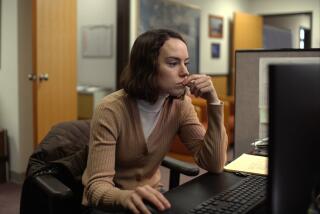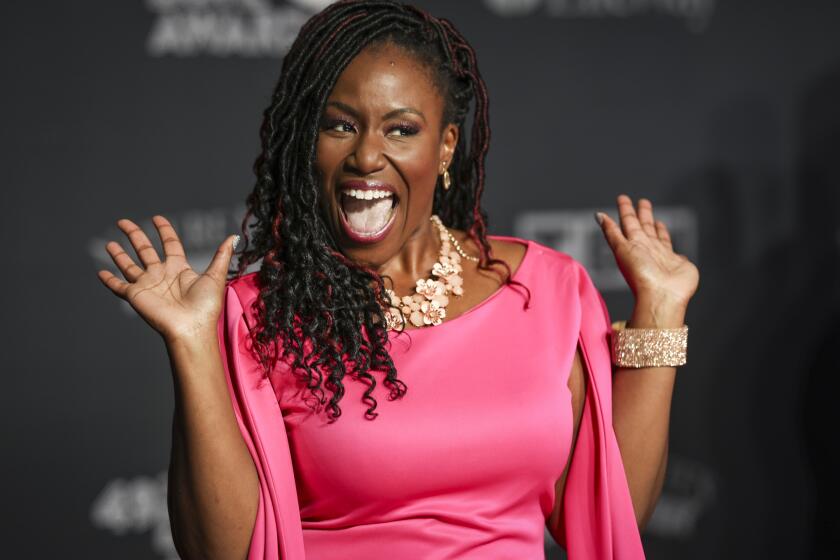Review: ‘Robin Williams: Come Inside My Mind’ is a poignant portrait of a comic giant and his vulnerability
Robin Williams, who has been four years absent from this world, is the subject of a bittersweet new documentary, “Robin Williams: Come Inside My Mind,” premiering Monday on HBO.
It feels about time to think about him again.
Directed by Marina Zenovich, who previously made the 2013 “Richard Pryor: Omit the Logic,” it’s an intimate, largely inside look at the actor-comic, a mosaic of clips and commentary from those who knew him pretty to very well. It will reinforce, not remake, his public image as a private sort of public person; a sensitive, sometimes insecure soul strapped to a rocket ship mind, a long-distance sprinter.
“Come Inside My Mind”— the title comes from a routine in which Williams portrays the brain of a bombing comedian (“Ego check, everything failing! Mayday! Mayday!”) — reflects that duality, putting an elegant frame around a manic action painting.
The film is not a personal tribute or a definitive deep dive, like Judd Apatow’s four-hour “The Zen Diaries of Garry Shandling,” also made for HBO. (It’s half as long, to start.) But Zenovich hits the main points, child and man, comic and actor, TV and movie star, Comic Relief co-founder and USO trouper, for poorer, for richer, in health and sickness, on drugs and off them. Made with the cooperation of family and friends, it’s an affectionate, sympathetic work – it was presumably not impossible to find a person with a bad word to say about him, though, I don’t know, perhaps it was. But that is not the plan here.
Williams’ life was continually documented while he lived it, and nothing here quite qualifies as a revelation. Still, much will likely be new to any given viewer. I, for one, did not know that Williams had two half-brothers, one from each parent, though each grew up essentially as an only child. Or that producer Garry Marshall’s son, Scott Marshall, was the reason an alien was introduced into “Happy Days.” (“Scotty wants a spaceman,” Garry told the writers room.) Or that the runaway Williams’ disinclination to hit his marks while taping “Mork & Mindy” led the director to add a fourth extra camera just to follow him, which then became standard practice in the industry.
Unlike most of his Comedy Store associates, Williams was an actor first, who studied at Juilliard under John Houseman; comedy was a sort of nighttime day job, as it were, that kept him going. Although as a comedian, Williams was very much a disciple of Jonathan Winters – there is a nice line drawn here between Winters improvising with a stick on Jack Paar’s talk show and Williams doing the same with Elmo on “Sesame Street” – he was his own, muscular artist.
David Letterman, who knew him in the Comedy Store days, remembers, “All I could really do was hang onto the microphone for dear life and here was a guy who could levitate.” As an actor, he liked roles that showed his sensitive side — he was more mature on screen than onstage.
The shape of any documentary is based on access – who wants to talk and the photos and footage you are able to get. Here we get a tape of Williams imitating a teacher in a high school assembly; riffing to drivers of passing cars (“Excuse me, we’re conducting an experiment in accidents on highways caused by distractions,” “Madame, please, please, I’m making a plea for love”); a cache of photographs by Arthur Grace, who followed him on the road for Newsweek in the post-”Mork” years, when “he was not getting ‘first class’ treatment in travel or anything else”; messages he left on Billy Crystal’s phone, not all as himself; video of his first son’s christening.
And there are many outtakes, interesting in the way an alternate take of a jazz recording might be — essential to understanding the ad-libbing artist, if less than essential art. (They’re fun, and usually vulgar.)
The testifiers include early-days girlfriend and fellow comic Elayne Boosler (“I’ve never been so pursued in my life”); first wife Valerie Velardi (but not second wife Marsha Garces, the mother of his two younger children, or final wife Susan Schneider, if you care to find any meaning in that); “Mork” costar Pam Dawber; and “Comic Relief” cohort Whoopi Goldberg.
A consistent picture of a divided person emerges. “It was vital for him to have an audience – it was hilarious, but it was a need,” says Bobcat Goldthwait; “Waiting for Godot” costar Steve Martin says, “Onstage he was the master, and in charge and funny and quick – and in life, he wasn’t onstage anymore.”
Billy Crystal notes comedians’ need for “that little extra hug you can only get from strangers.” Lewis Black calls him “the light who never knew who never how to turn itself off.” Son Zak Williams says, “His pathos was seeking to entertain and please and he felt when he wasn’t doing that he was not succeeding as a person.”
There is pathos, too, just in the passage of time. Young Robin was a rock-star comic; when Dawber saw him after 20 years, as a guest on his final sitcom, “The Crazy Ones,” she thought “he looked like a wax figure.” Williams was then experiencing the symptoms of the diffuse Lewy body dementia that may have contributed to his suicide.
But every life-encompassing biography is a memento mori of sorts, a reminder that death comes to us all, and to end on a life-affirming note, Zenovich turns first to San Francisco Bay, where the actor’s ashes were scattered, to a clip of “Dead Poets Society” for her finish, as Williams’ English teacher encourages his life-fearing students to seize the day. “You’re only given a little spark of madness, and if you lose that, you’re nothing.”
Review: ‘Richard Pryor: Omit the Logic’ a keen look at gifted comic
Robin Williams ran a comedy marathon at a sprint
Judd Apatow on his new HBO doc and how Garry Shandling sparked the New Golden Age of Television
Follow me on Twitter at @LATimesTVLloyd
More to Read
The complete guide to home viewing
Get Screen Gab for everything about the TV shows and streaming movies everyone’s talking about.
You may occasionally receive promotional content from the Los Angeles Times.







